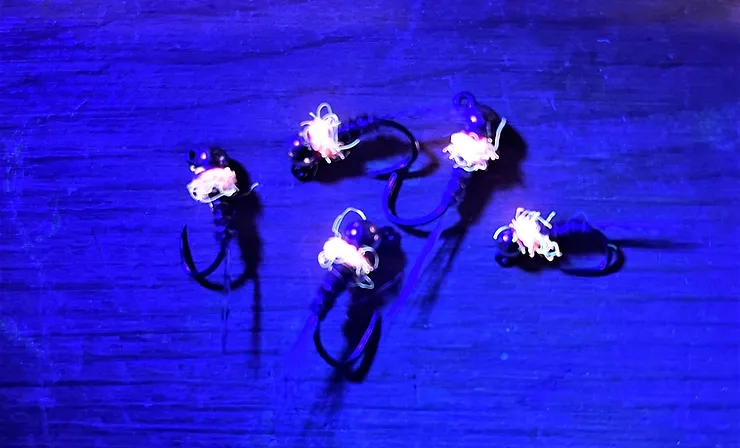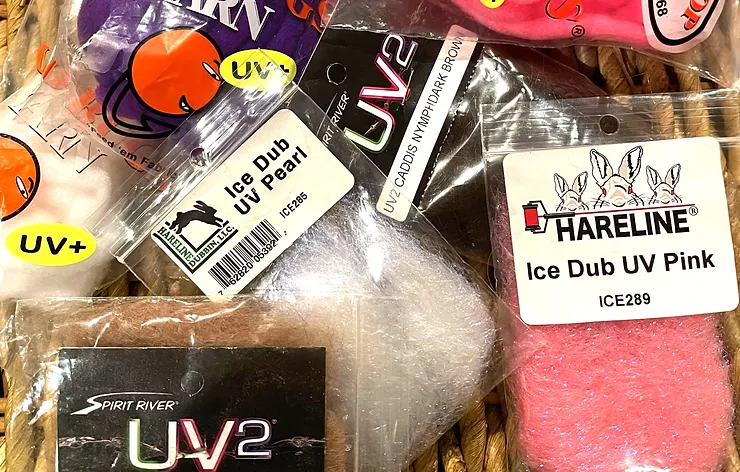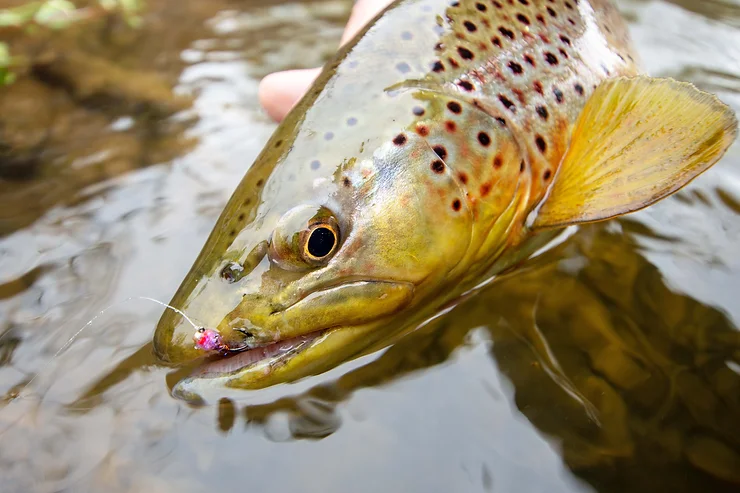Do UV Flies Catch More Trout?

The old joke is that lures are meant to catch fishermen, not fish. Flashy, bright colors and intricate, realistic designs cause us to cough up the coin in hopes that we’ve found the next great thing. In some ways, UV materials have been that next great thing in the fly fishing industry over the past 20 years. It’s hard to go into any fly shop nowadays and not see the shelves lined with UV-enhanced dubbing, chenille, egg yarn, etc. And I wouldn’t doubt that patterns that incorporate UV materials are some of the best-selling flies right now.
However, with UV-enhanced materials – as well as the flies tied with them – typically comes a little higher price tag. Depending on the brand, that price tag can be significant. Eventually, you have to ask, are UV products worth the extra money? And do UV flies catch more trout?
What is UV light?
Ultra-violet (UV) light is a type of electromagnetic radiation. According to LiveScience, “Electromagnetic radiation comes from the sun and transmitted in waves or particles at different wavelengths and frequencies. This broad range of wavelengths is known as the electromagnetic (EM) spectrum. The spectrum is generally divided into seven regions in order of decreasing wavelength and increasing energy and frequency. The common designations are radio waves, microwaves, infrared (IR), visible light, ultraviolet (UV), X-rays and gamma-rays.”
If you’re like me, you may have to read that description two or three times to understand it. In layman’s terms, if electromagnetic radiation were a radio dial, visible light is the only station that would come in clearly for humans, and everything else would basically be static, if not complete silence. Although a trout’s eye is relatively similar to a human’s, a trout has the ability to tune in more channels on the radio dial, UV light in particular, because it has an extra set of cones in its eyes that are dedicated to UV light reception.
But here’s the sticking point among fishermen: everyone agrees that trout are born with the ability to see UV light. In fact, it’s one of the ways in which young fry find food. The disagreement comes with how long trout actually retain the ability to detect UV light.
The latest research suggests that the UV-dedicated cones in a trout’s eye disappear as the fish matures, which for stream-born wild trout occurs shortly after losing their parr marks, when they’re only a few inches long. (Here’s an article from Fly Fisherman about the topic.) So by the time a trout is a young adult/adult, it no longer has the ability to detect UV light – probably because it doesn’t need to because it is more adept at catching prey by then.
However, some scientists suggest that UV light detection doesn’t actually disappear – it just goes dormant. As this article from Trout & Salmon in 2020 states, “Migratory trout regain UV light perception on returning from the sea. They also detect polarised light, which tells them when dawn and dusk are happening and stops them confusing that with changes in cloud cover.”
What is unclear, though, is if this refers to ALL migratory trout. Since Trout & Salmon is a U.K.-based publication and website, are they referring to ONLY sea-run fish, or is this also common in freshwater fish that may run upstream, within the same body of water or watershed, to spawn each year? A scientific study focusing on that aspect would be an interesting read.

UV-enhanced materials have become commonplace in the fly fishing industry. But do UV flies actually catch more fish than “regular” flies?
UV Flies for Stocked Trout Versus Wild Trout
In the wild, a stream-born trout loses its parr marks at approximately one year of age, which is about the time that their UV-sensing cones start to diminish. Therefore, it would make sense that UV flies would have no added advantages over any other patterns for wild, stream-born trout.
Stocked trout might be a different story, though. Stocked trout are raised under ideal circumstances – constant water temperature, constant food source, and very little stress. They grow at a much faster rate than wild fish.
According to the Pennsylvania Fish and Boat Commission, the average stocked trout in PA is 12-15 months old. (By comparison, brooder trout, aka “trophy trout”, stocked by the PFBC are 2-3 years old.) Considering the relatively young age of the average stocked trout in Pennsylvania, it’s very possible that the majority of these fish still retain at least some ability to detect UV light. (Note: this is assuming that maturity is achieved with age rather than simply size.)
This poses another question in regards to the ability to perceive UV light disappearing or going dormant in migratory fish. In the case of Lake Erie, where many of the steelhead that spawn every fall are plants from the hatchery and not actually stream-born fish, would they also experience an increase in UV-sensing capabilities once they began to run up the various tributaries? Again, I would love to know if this phenomenon is unique to sea-run fish or if it also applies to freshwater species.
Fluorescence and Contrast
From LiveScience comes this explanation of fluorescence: “Many substances — including minerals, plants, fungi and microbes, as well as organic and inorganic chemicals — can absorb UV radiation. Absorption causes electrons in the material to jump to a higher energy level. These electrons can then return to a lower energy level in a series of smaller steps, emitting a portion of their absorbed energy as visible light. Materials used as pigments in paint or dye that exhibit such fluorescence appear brighter under sunlight because they absorb invisible UV light and re-emit it at visible wavelengths. For this reason they are commonly used for signs, safety vests and other applications in which high visibility is important.”
This reminds me of a day I had on Pine Creek near Slate Run last spring. I was using a Y2K egg pattern in pink/yellow that was tied with “standard” egg yarn rather than yarn with UV enhancers. The fly was kind of dull in appearance. I caught a couple of trout, but I knew there were a lot more in there that I should’ve been catching, so I tied on a Y2K in chartreuse/orange. Both colors utilized UV-enhanced egg yarn. Over the next two hours, I absolutely annihilated the trout.
The water that day was on the higher side, slightly cloudy but not murky, and the sky was overcast. In the moment, I thought the reason trout were keying on that Y2K was because they happened to be hot for chartreuse and orange that day. Looking back, though, I think the real reason is that they could just see those colors better in that particular situation. In this instance, the UV materials had a greater presence in those water conditions.

The white egg yarn on the left incorporates UV enhancers. The white egg yarn on the right does not.
Overall, UV flies and materials tend to come in brighter colors or at least have more sparkle in them. This extra added sparkle provides contrast, which is the real key to why some flies work better than others in certain situations. When a nymph tied with UV materials is bouncing along the stream bottom, where visibility isn’t as clear for trout, those little bits of sparkle help the fly stand out from the rocks and any other substrate.
This applies to fluorescent colors as well. Although they lose their vibrance in deeper water, fluorescent colors still capture more light than their naturally-colored surroundings, making them more noticeable and appear more vulnerable to trout. Keep in mind, too, that trout are naturally curious creatures. Sometimes, they’ll suck in something just because it catches their attention, not necessarily because they think it’s food.
I’ve always been a believer in contrast, and we certainly see that in many of today’s most popular – and effective – fly patterns. Flies such as the Frenchie, which is basically a Pheasant Tail Nymph with a hot spot, is a prime example. The hot spot provides a nice contrast to the darker body of the nymph, causing it to stand out better against the stream bottom and making it vulnerable and more likely to get eaten.

This Frenchie tied with a collar of UV pink dubbing was just what the doctor ordered for this hefty wild brown. Did the UV actually make a difference in whether or not the fish hit the fly? There’s no way to know for sure. And we may never know if UV flies offer an advantage…unless we are reincarnated as trout after death.
So Do UV Flies Catch More Trout?
In short, the answer is probably yes, UV flies catch more fish – but maybe not for the reasons we think. In my humble opinion, UV flies work well simply because they tend to be brighter and have more sparkle than flies tied with materials that don’t have any added UV enhancers. These features create more contrast, which in turn catches the trout’s eye a little more and allows the trout to key in on the flies a little better.
Of course, the same effect could be achieved just by adding flash to your nymphs, or creating more contrast with hot spots and various styles of beadheads, rather than re-tying everything with UV materials. Always keep in mind, though, that UV flies are not the “secret sauce” to endless glory days on the water. Like everything else, they have a time and place, and there are plenty of times when they don’t work and are, in fact, out-produced by nymphs with no flash at all.
But the main reason I think UV flies probably catch more fish is because they catch more fishermen. Flies tied with UV-enhanced materials are just a little prettier, a little flashier, and are probably used more often than other nymphs. They may not add a single extra trout to the tally at the end of the day, but they can definitely add confidence, and that’s not something to disregard. Even if UV flies don’t have a single benefit, sometimes just believing they do can make all the difference.
Sign up for the Dark Skies Fly Fishing e-newsletter
It's free, delivered to your inbox approximately three times each month.
Sign Up Now
Very compelling article, Ralph. Clearly, with conviction, you did your homework to compose this piece. Most interesting is that wild trout maintain their parr marks and achieve what I believe based on anecdotal observations an average length of 5-7 inches in twelve months of age in PA. Comparatively, their stocked counterparts are the size of adults, 9-13 inches, on average in 12-15 months. I guess this is a result of living in a near constant environment, without predators and strong currents to contend with while being fed a regular and high-protein diet.
I’m not 100% sold on UV flies and have yet to tie with these materials. I feel that I need to begin experimenting with it and learn if my catch rates improve. Additionally, I feel that more research can be conducted concerning trout eyesight anatomy and evolution.
Great information. Thank you for sharing!
Justin
Hey Justin, thanks for taking the time to leave a comment! I truly appreciate the feedback. I’m not 100% sold on UV flies either, to be honest, although I tie and use them fairly regularly. Like anything, they probably have their place, but they’re certainly not the end-all of fly fishing. The only way we will ever know exactly what fish see is if we are someday reincarnated as trout.
As I said at the end of the article, the main reason UV flies might catch more fish is simply because fishermen use them more often. They’re all the rage right now. They’re trendy. Fishermen use them more because they believe these flies give them an edge, and maybe they do — not because of the UV but simply because they believe they do. There’s something to be said about having confidence in what you’re using, even if it has no scientific advantage whatsoever. Those same fish (and maybe even more) could probably be caught with “regular” flies. Regardless, it’s only speculation.
Well done, I find your analysis to be very interesting. I also have had certain flies appear to perform better in high or cloudy water that were tied with UV collars or hotspots. From my perspective why UV flies work is not as important as the fact that they offer another option to try and it is my opinion that in very low clear water the opposite may be true, meaning they may look unnatural and cause some fish to spook.
Very interesting, but I disagree that UV catches more fishermen than fish. We just don’t understand which materials show up the UV light (what part and how much) in the spectrum of the aquatic biota which trout feed upon! Some exoskeletons, some internal organs or some completely external materials to the insect, bug or other microfauna must be a part of the range of UV absorbent materials which attract fish! Great field for imagination and experiment for a fisherman!!
Hi JB, thank you for reading the article and taking the time to comment. I truly appreciate your feedback! Truth is, none of us will ever know exactly what a fish sees. My theory that UV catches more fishermen than fish is based on the fact that science tells us that trout lose their ability to sense UV light once they mature. But you’re absolutely right…great field for imagination and experimentation! And who knows, maybe in a few years, science will change its opinion (as it often does) as new technology becomes available and perhaps we someday discover that trout actually do see UV light!